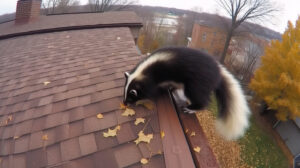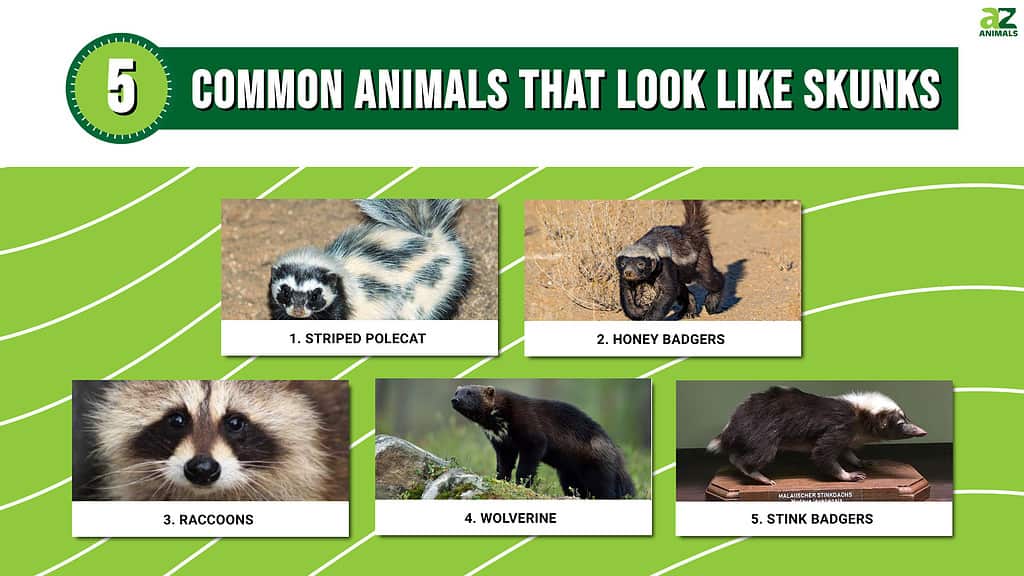
Have you ever wondered how two animals could look so similar that you confuse them? There are many such examples, like dolphins and porpoises, moths and butterflies, or seals and sea lions. The skunk is another animal with a lot of natural doppelgangers. Skunks are famous mammals known for their unpleasant smell and unique body coloration. These are interesting traits they share with a number of animals. As a result, unsuspecting observers often mistake other black-and-white, striped mammals or animals that produce foul-smelling fluids for skunks. Check out our list of five common animals that look like skunks and how you can distinguish them.
About Skunks
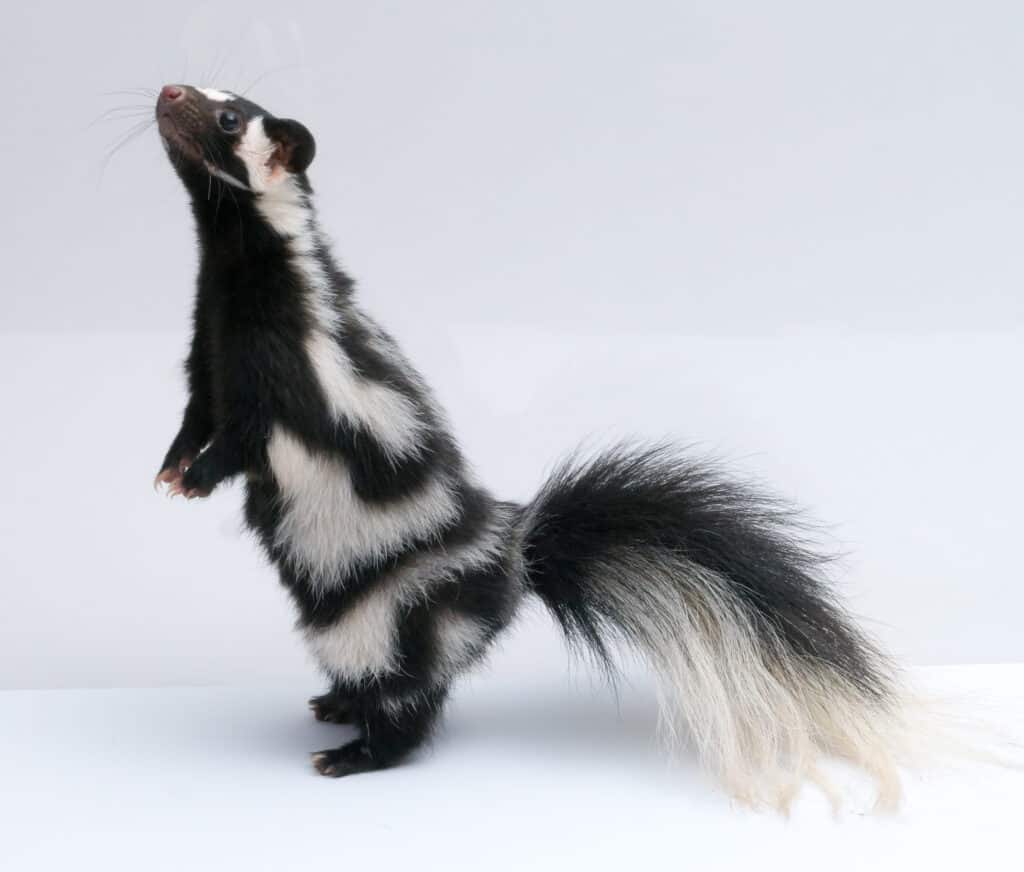
Skunks are solitary animals.
©JayPierstorff/Shutterstock.com
- Skunks belong to the Mephitidae family. The mammals grow to about 15.6 to 37 inches and weigh about 18 pounds.
- Skunks have long front claws for digging and a moderately elongated body. The most common fur color is striped black and white, while a few species are brown and gray.
- Skunks are omnivores and are notorious for secreting a foul spray containing sulfur from their anal scent glands.
- Skunks are solitary animals but will live in a colony of up to 20 during winter.
- Skunks are predominant in South and North America, including Southern Canada, Northern Mexico, and the United States.
Common Animals That Look Like Skunks
1. Striped Polecat

Striped polecats are popular for their foul anal spray.
©Michal Sloviak/Shutterstock.com
The striped polecat is the closest you’ll come to a skunk based on appearance and behavior. Like the skunk, the striped polecat has stripes running from its head down its back and on its cheeks. They are also mostly black on the underside and white on the tail, and they have white ears and white spots on their head. Apart from this, the polecat is popular for its foul anal spray as the primary defense against predators. The spray released by anal stink glands is powerful enough to irritate the mucous membrane or temporarily blind their adversaries. Striped polecats have small bodies, with males larger than females. They can grow to 24 to 28 inches in length and weigh up to 2.9 lbs.
How to Tell The Difference
Skunks are omnivores that live in colonies of over 20 animals. In contrast, the striped polecat is a carnivore that prefers to live solo. Apart from this, the foul odor produced by polecats is not as strong as that of a skunk. Skunks are more aggressive and have been known to attack humans when threatened, while polecats are less aggressive and reserve fights for confrontations.
2. Honey Badgers
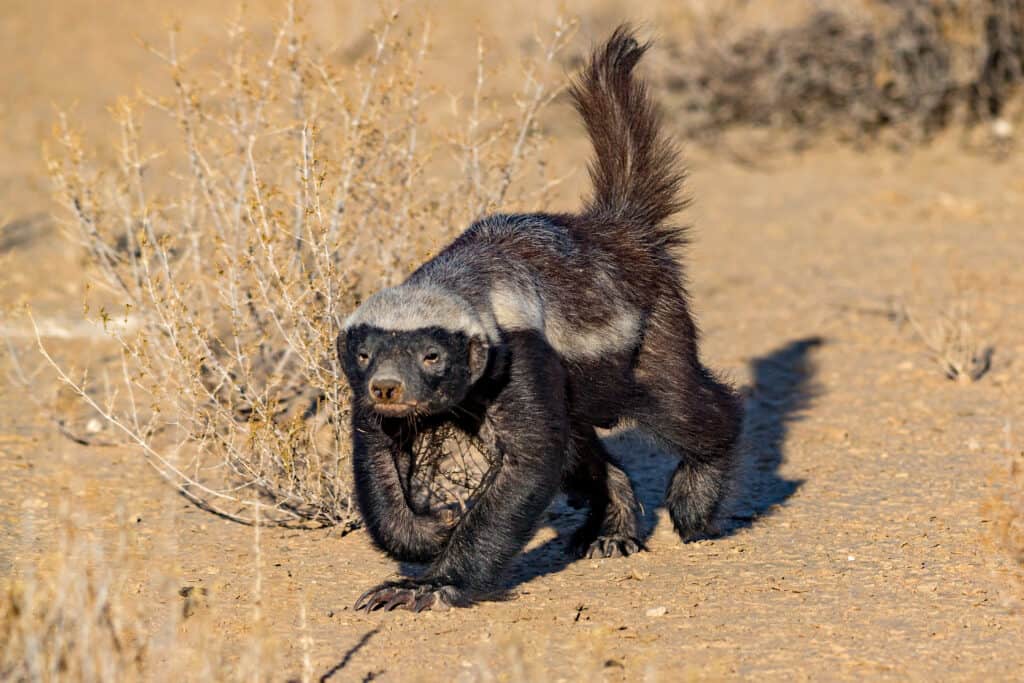
Some honey badgers have black and white fur similar to skunks.
©Braam Collins/Shutterstock.com
The honey badger is another animal that is often confused with the skunk. Although the two animals are not closely related, they share the ability to use smell as a defense against enemies. Like skunks, honey badgers have a gland at the base of their tail for dropping stink bombs on enemies. Apart from this, some honey badgers have black and white fur similar to skunks. Both animals eat snakes and scorpions since they are immune to their venom. But this is where the similarities end.
How to Tell The Difference
The primary difference between a badger and a skunk is size. They also differ in terms of their defense mechanism and distribution. Badgers are larger than skunks. They weigh up to 30 pounds and have a more rounded body. The animal has a small, flat head with a short muzzle, and its skin is remarkably thick. They are more ferocious and devour all parts of their prey, including the feathers, skin, flesh, and bones. Unlike skunks, honey badgers don’t spray foul odors. Instead, they drop stink bombs. As a result, the effect is not as powerful as a skunk’s. Honey badgers have short tails, whereas a skunk’s tail is fluffy and long. There are also 15 species of badgers present in almost every continent, whereas skunks only live in North and South America.
3. Raccoons
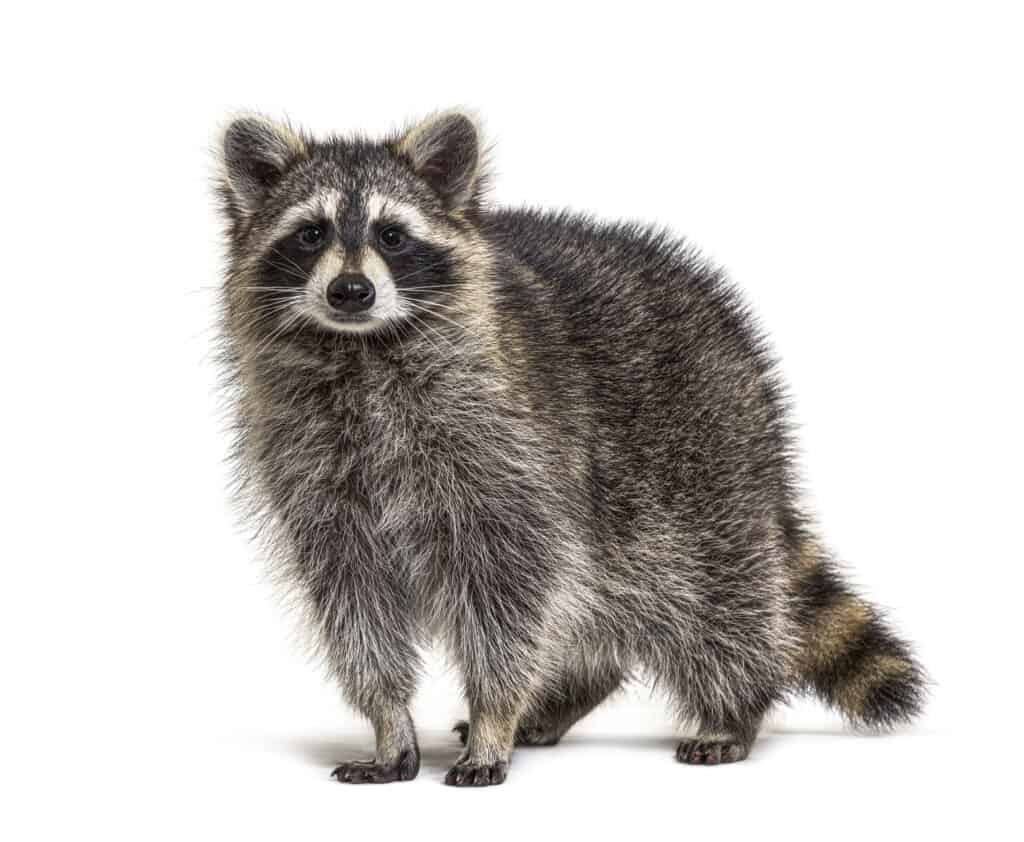
The raccoon is heavier than the skunk.
©iStock.com/GlobalP
Raccoons and skunks are omnivores. But more importantly, they are both ferocious hunters that prefer to hunt at night. However, the most striking similarity is their distinctive black-and-white appearance. Raccoons have a black fur area around the eyes, contrasting the white face surrounding them. Going by the fur color alone, both animals appear similar. However, they are not.
How to Tell The Difference
Raccoons are heavier, while skunks have longer bodies. Raccoons measure between 16 and 28 inches and weigh up to 58 pounds. Apart from these differences in size, raccoons are excellent runners, climbers, jumpers, and swimmers. Although skunks can swim, they prefer to spend less time in the water. Raccoons, on the other hand, can stay in the water for several hours. They have a hyper-sensitive sense of touch and great eyesight. In contrast, skunks have poor vision and cannot see objects over 10 feet away. But the most significant difference between them is the stink. Unlike skunks, raccoons cannot produce a foul-smelling spray as a defense against other animals. Instead, raccoons have teeth for hunting and defense purposes.
4. Wolverine
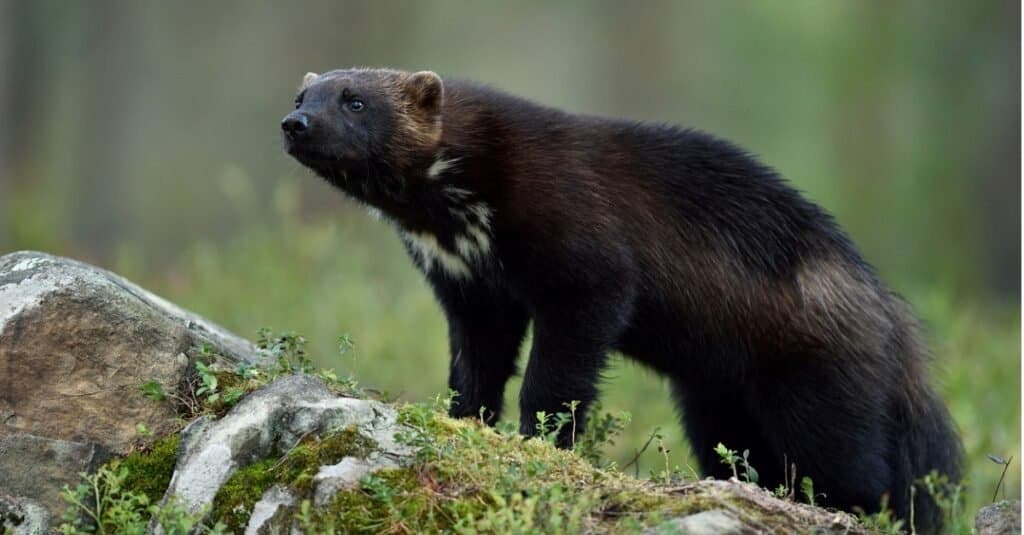
Wolverine are very quick and can run at speeds of up to 30 miles per hour when chasing prey.
©iStock.com/ErikMandre
The wolverine is the largest land-dwelling species of the Mustelidae family. Like its X-men movie figure adaptation, the wolverine is a ferocious animal, reputable for killing prey larger than itself. Wolverines are distributed primarily in Alaska, Russia, Siberia, Northern Canada, and the mainland Nordic countries of Europe. Like skunks, wolverines have scent glands for producing pungent stinky substances for marking their territory and signaling mates. As a result, they are often called skunk bears. Both animals have black and white stripes down their back, except the stripes are more pronounced in skunks.
How to Tell The Difference
Although they look similar, the stripes on a wolverine are blotchy, and their body is shaped differently. The animal has highly hydrophobic and frost-resistant oily fur. The wolverine also has a light-silver mask and a pale buff stripe that runs from the shoulders along the side. They are larger than skunks, weighing up to 70 pounds, with a body length of 22 to 44 inches. The omnivore is more of a scavenger, and the primary purpose of their anal scent glands is not for defense but for marking their territories.
5. Stink Badgers
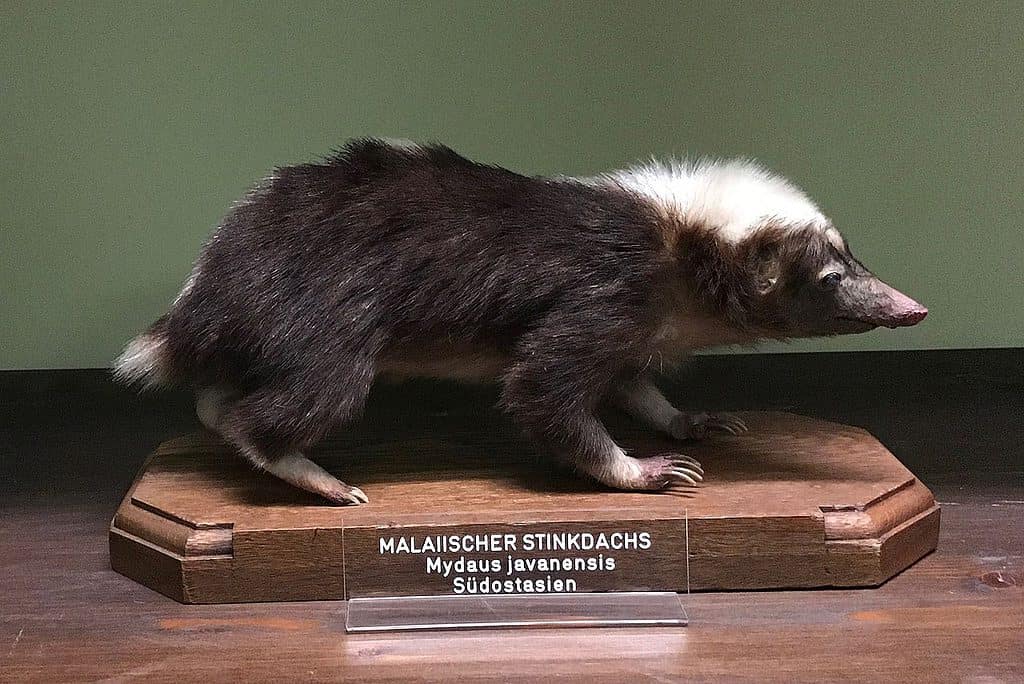
The stink badger prefers to eat worms and insects.
©U.Name.Me / CC BY-SA 4.0 – License
Stink badgers and skunks belong to the same Mephitidae family. DNA analysis also shows they share a common ancestor with the skunks. Therefore, the fact that people can’t tell them apart is understandable. The stink badger lives only on the western islands of the Greater Sunda Islands. As the name implies, they are popular for their foul-smelling secretions. Like skunks, stink badgers expel liquid from their anal glands in self-defense.
How to Tell The Difference
Despite their similarities, stink badgers are quite different from skunks. There are only two species of stink badgers — the Palawan stink badger and the Malayan stink badger. Little is known about the Palawan stink badger except that it is from Palawan and the neighboring Philippines Islands. Likewise, the Malayan stink badger lives in mountainous areas of Southeast Asia. The shy and nocturnal badgers are not excellent diggers like skunks and prefer to eat worms and insects.
Conclusion
Skunks are primarily identified by their distinct white and black stripe and noxious spray. However, they are not the only animals with one or both of these features. All five animals above look like skunks and share common traits enough to make people confuse them for skunks. However, a closer look at these common animals that look like skunks will show some clear differences between them, enough for you to tell them apart.
The photo featured at the top of this post is © JayPierstorff/Shutterstock.com
Thank you for reading! Have some feedback for us? Contact the AZ Animals editorial team.



